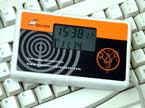| Galleon | Atomic Clock | Time servers | Computer Time | CCTV | Time and attendance | Digital Wall Clocks | Time server products | Contact | |
|
FAQ
|
Frequently asked questions | |
 Workstation Atomic Radio Clock
|
Quick links: MSF and DCF Time Receiver
gps time receiver
time synchronization for atomic clocks network time protocol (ntp)
what are the advantages of the professional antenna ? the professional msf and dcf antenna's allow the antenna to be sited well away from any computer generated interference. The antenna is IP66 rated and so can be mounted out-doors, if required. Additionally, it can also utilise CAT 3 or better point-to-point structured cabling. This means the radio time receiver is continually listening for the radio signal, which is ideal for low signal strength areas. Where is the best place to put the antenna ? The location of any of the radio antenna's is very important. the antenna should be located away from electrical interference generated by computer monitors or any other electrical equipment. the antenna needs to be located above-ground (preferable on top of a building) and not be shielded by any metal frames or objects. what is the maximum cable length for the antenna's ? The maximum cable length for the Low-Cost MSF and DCF antenna's is 12 meters of which 2 meters is supplied. the maximum cable length for the professional msf and dcf antenna's is 100 meters, of which 5 meters is supplied. What coverage does the MSF and DCF radio signal have ? The MSF-60 radio time signal provides accurate time information up to 1500 kilometres from the transmitter at Rugby, UK. The transmission range covers the entire United Kingdom and much of north and west Europe. The DCF-77 radio time signal operates across much of Central and Western Europe. GPS can provide accurate time information worldwide using the Global Positioning System satellites. What are the advantages of the Professional GPS antenna ? The Professional GPS antenna can act as a stratum 1 time source anywhere in the world. The antenna also provides accurate continuous timing information. Where is the best place to put the GPS antenna ? The GPS antenna needs to be located with a good clear 360 degree view of the sky. The ideal location for the antenna is a roof-top. However, in practice the antenna generally works well on a window-ledge or positioned in a window. What is the maximum cable length for the GPS antenna ? The maximum cable length for the Professional GPS antenna is 25 meters. What coverage does the GPS signal have? The GPS signal can provide accurate time information worldwide using the Global Positioning System satellites. Time Synchronization What is the accuracy of the radio and GPS time signal ? The radio and GPS time signals are controlled by atomic clocks. An atomic clock is accurate to 1 second in 1 million years. Typically, a Windows PC can be synchronized to an accuracy of 20 milliseconds (0.020 seconds). Network Time Protocol (NTP) What is Network Time Protocol (NTP) ? Network Time Protocol (NTP) is a client-server UDP protocol for synchronizing the time on IP networks. It was designed to synchronize the clock on client machines with the clock on network time servers. Using NTP packets, the client and server can exchange time information to accurately set the client machines clock. The TimeSync NTP and Enterprise Time Servers are examples of NTP Servers. TIME-SYNC NTP Client are examples of NTP client applications. Can NTP be used to synchronize routers and other equipment ? NTP can be used to synchronize the time on any computer equipment that is compatible with the Network Time Protocol. This includes CISCO routers and switches, UNIX machines and Windows machines with a suitable client, such as TimeSync NTP Client. Can NTP be used to synchronize Novell servers ? Yes, Novell 4.x, 5.x and 6.x has an integral NTP client that can synchronize to a NTP server. Novell 3.x is not supplied with an NTP client but they are available from the internet. What is a Stratum 1 Time Server ? A Stratum 1 Time Server is a NTP time server that is able to synchronize to an accurate external time source. The external time source can be an MSF or DCF-77 radio clock or a GPS clock. Galleon can provide radio or GPS solutions. Can TimeSync NTP be used with W32Time ? Yes, W32Time for Windows NT and Windows 2000/XP can be configured as an NTP client. However, many users have reported configuration difficulties and poor time accuracy. TimeSync NTP Client is very easy to install and configure and is accurate to fractions of a second. |
|
|
For more information about Galleon Systems and products Contact Galleon .
|
Telephone Galleon: 0121 608 7230 | International:+44 121 608 7230
|
|
Home | Correct time for computers | CCTV | OEM Modules | Time and Attendance | Product Finder | FAQ's | Contact | Galsys.co.uk || |
| | | |
© Galleon 2003